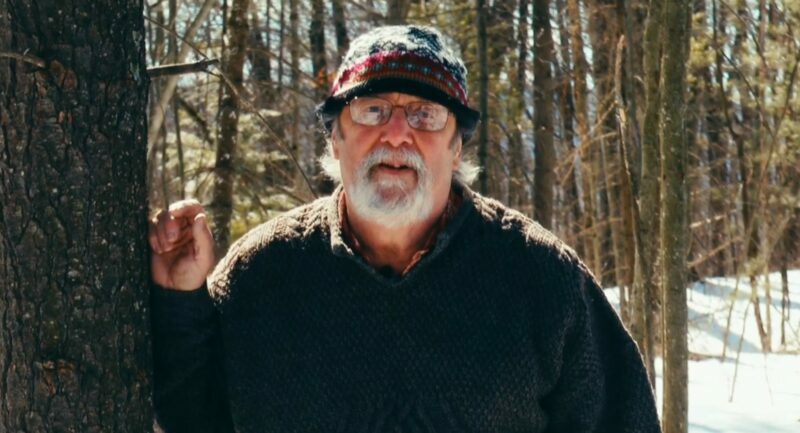BELLOWS FALLS — An artist, writer, and anthropologist, Charles Norris-Brown died unexpectedly last October. Highly regarded on the Bellows Falls arts scene, he is remembered well in an exhibit at Bellows Falls' Canal Street Art Gallery (CSAG) through June 10.
“Charles W. Norris-Brown: Distant Thunder Studio” presents original work from the late artist's unfinished graphic novel Thunder Basin within a recreation of his studio at CSAG.
Viewing finished illustrations, studies, storyboards, and writings, visitors, according to CSAG's website, are welcome to explore Norris-Brown's notebooks, plein-air studies, sketchbooks, brushes, and palettes.
The exhibit will offer art supplies and a space to create for those “inspired [to] write, draw, and paint with watercolor or ink, [and] to make their own artwork and writing about Thunder Basin.”
In the book, “a girl loses her beloved cell phone in the forest. Trickster Coyote picks it up and runs away with it, leading her to explore the forest, and ultimately, herself. This quest unfolds in the Thunder Basin along the west flank of Mt. Mansfield, Vermont.”
Asking questions
Norris-Brown was born in 1946 in Warren, Pennsylvania. With a doctorate in social anthropology and sociology from Lund University in Sweden, Norris-Brown did post-doctoral work as a University of Massachusetts at Amherst research associate in India, Borneo, Appalachia, and Canada where his focus was “on people of the forests and on their place in the health of the ecosystem.”
Having moved in 2016 to Bellows Falls from Burlington, Norris-Brown's academic path saw him as an adjunct faculty member at the University of Vermont and, previously, at the University of Pittsburgh. Developing as an artist since his youth, Norris-Brown merged those talents with a quest for an ever-deeper understanding of human form, function, and vulnerability as his art eclipsed his academic life.
“In my life, I have always asked questions,” he wrote on his website. “I acted on my own conscience as much as I could. Now it is my wish that my work contribute to the pressing need not only to share facts but to reach into people's hearts to understand Nature and both what threatens it as well as its wonder. Children are a very important part of this. They are the future, and they are willing to listen.
“My work has had one foot in deep theory (systems and evolution) and another in the field,” he wrote. “It has taken different directions, but it has always been inspired by an awe of the beauty of the world.”
Norris-Brown wrote that he used media that were “as close to Nature as I can get: charcoal, pencil, and ink. For me, watercolor shares the freshness of bubbling brooks, a forest breeze, the color of a sunset, and the curve of a child's finger.”
He entered the world of children's books as a writer-illustrator with Did Tiger Take the Rain? (Green Writers Press, 2016) summarized as such: “In a Tharu village in the Nepal terai, it has been uncommonly hot and dry. One day, a tiger comes. People run away in fear. The villagers think it is a bad omen and that the tiger has taken the rain.”
For material on the story aimed at raising awareness around deforestation, Norris-Brown traversed Nepal in search of myths and stories related to tigers.
Norris-Brown's illustrations are, in turn, poignant, evocative, ethereal with gentle brushstrokes and shadowy images contrasting piercing, knowing eyes on full-front faces.
“It is such a joy to be able to draw or paint what I see,” he wrote, “to engage the beauty of the world and let it flow through my mind and my hands onto paper. I want to remain open to the impressions, merge them with a life full of experience and thought, and create a statement.”
Memories of an artist
Fellow Bellows Falls artist Clare Adams remembered Norris-Brown.
“Charles was great,” she said. “I ran into him everywhere - he was very involved in the arts scene here with Robert McBride and [Rockingham Arts and Museum Project], and [with] Main Street Arts, where he was on the board and taught figure drawing.”
He was keen, Adams added, on working to create Bellows Falls as a place for artists to come, have community, and support one another.
“He cared a lot about people,” she said. “He has left a void that will be hard to fill.”
About Norris-Brown's work, Adams said that he looked at things on a deeper level - especially given his work in anthropology.
“He had a grasp on what was going on,” she said.
Fellow artist Melissa Rubin recalled that when she was new to the area several years ago, Norris-Brown was one of the first artists she met.
“I was drawn to his thoughtful, quiet manner reflected in his work which is exquisitely beautiful,” she said, adding that Norris-Brown “created community among humans and nature.”
A supportive community
Michael Noyes, director of Canal Street Art Gallery, recalled that “Charles often chose people and animals as subjects. These subjects communicate the artist's desire to reach people through an understanding of nature - both what threatens it, as well as its wonder.”
He said that Norris-Brown's “anthropological research on people of the forests, and their place in the health of the ecosystems there, brought [him] to focus on creating figurative artwork depicting people embracing nature.”
Canal Street Art Gallery represents Adams and Rubin among its roster of almost 30 artists.
Adams said the gallery “has a feeling of community and cooperation - it's not competitive. Michael has developed an atmosphere where artists can get to know each other and be supportive. It's where artists are encouraged to try different work, to take risks.”
